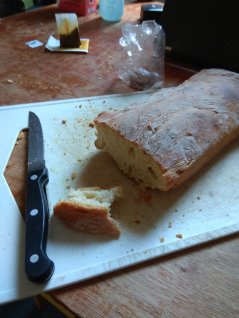
The story of bread baking
This week's blogger Sebastian (student International Development Studies) will explain how to bake your own bread.
Bread is a pillar of cultural significance. Bread can team with butter to be ‘the bread and butter’ or that which sustains someone. However, being on bread and water is ‘the bare necessity’. When you lose your bread and butter, you have to live on bread and water… in any case, the bread is there to stay..
I lost my job last week, the first thing I did after being fired was nothing…
After a while, nothing becomes dangerously unfulfilling so I substituted nothing for something.
That something was bread.
Now it might sound frivolous to fill that hole in your soul with bread.
But I can recommend it to anybody… come to think of it, do you know how to bake bread?
No really, in a country like the Netherlands, where people take a jar of peanut butter and bread to work and call it ‘lunch’, you should expect people to at least know how bread works! I did a small poll under my Dutch house mates; all 4 of them never baked a loaf of bread in their life. This is quite embarrassing I think, but maybe not that surprising… My girlfriend, who is Italian, tells me that ignorance is the only explanation as to why we put up with the spongy crap we collectively buy at the supermarket every week (2 loafs out and 4 in the freezer so we can last the week). And she was right… I did not know the joy of eating a real bread, the feel of kneading the dough, the smell of bread in the oven in the morning. But that was all about to change.
So, I started to bake bread in my student house, since we are fortunate enough to have an oven.
- How do you start you ask?
Well, the first step was finding a yeast culture. Because if you are serious about bread, you cannot be bothered to buy yeast every time,
No, a real bread baker grows his own yeast. An ex-housemate had some sour dough and so we got a tiny little blob, we call her ‘Maya’ you know… motha yeast! Just feed her one spoon of flour and half a spoon of water every day and she stays fit and healthy.
Bread does not need more then 3 ingredients, flour, water and yeast. I like to be minimalist about these things. You can flavor up your bread with salt, olive oil, fruits, seeds and nuts, but they are ‘artistic preferences’ and by no means necessities. And don’t get me started about all the crap they put in the bread in the supermarket in order to preserve them. When you bake bread in the morning, and live with 8 people, you know it is not going to last long, so we don’t need to worry about that.
We should probably talk about flour now… the flour determines everything. There is a whole world of flour out there, so you can play around with different kinds of flour. We had a housemate bake a loaf of bread with buckwheat flour by accident last week, it did not taste very good, but it is possible! Another determining factor is the structure of the grain. Wheat flour for instance, is much finer than wholegrain. This also changes the amount of water you will need to make the dough.
So how do you go about making dough… There are some artistic choices to make here, the wetter the dough the fluffier your bread. Generally you want your dough to be on the wet side, but not so wet that it becomes unmanageable. Now, this is very important, there is an order to things. You cannot just put all the ingredients together and throw it it the oven, oh who am I kidding, you can… and that is exactly what I did the first day. The result was not all that bad, there is not much that can go wrong when you only use three ingredients, so go out experiment with that dough! The bread was tasty, but kinda flat.
Now the science on how exactly this helps the dough to rise is unclear. The easy explanation is that the stretching and folding creates many layers for gasses to be trapped in. The more complicated answer involves a lot of chemistry. The bottom line is that it works! This is also why you want to handle your risen dough in the morning with a lot of care. As to not squash all the gas out of your dough, remember, stretch and fold.
Now when I wake up in the morning, I have a reason to get out of bed again. I get up, turn on the oven, wash myself and by the time that I’ve finished my coffee the bread is in the oven. The wonderful smell of baking bread surrounds me. Baking bread is a never ending spiritual journey, when you bake your bread in the morning you feed your yeast, which grows during the day, in the evening you use half of the yeast to make your dough, which rises during the night, and the cycle continues.
To a certain extend we are all experiencing chaotic and uncertain times. And in times of change it is doing things with care and attention that keeps me connected to reality. I hope you might find some reason in the things you do. I think that is very important in these times, and maybe if you are lost, try baking some bread.
Do you have a unique, fun or exciting hobby you would like to share with us and the rest of the WUR community? Send an e-mail to online.events@wur.nl with a short story and some photos and maybe you will be featured on this page!

